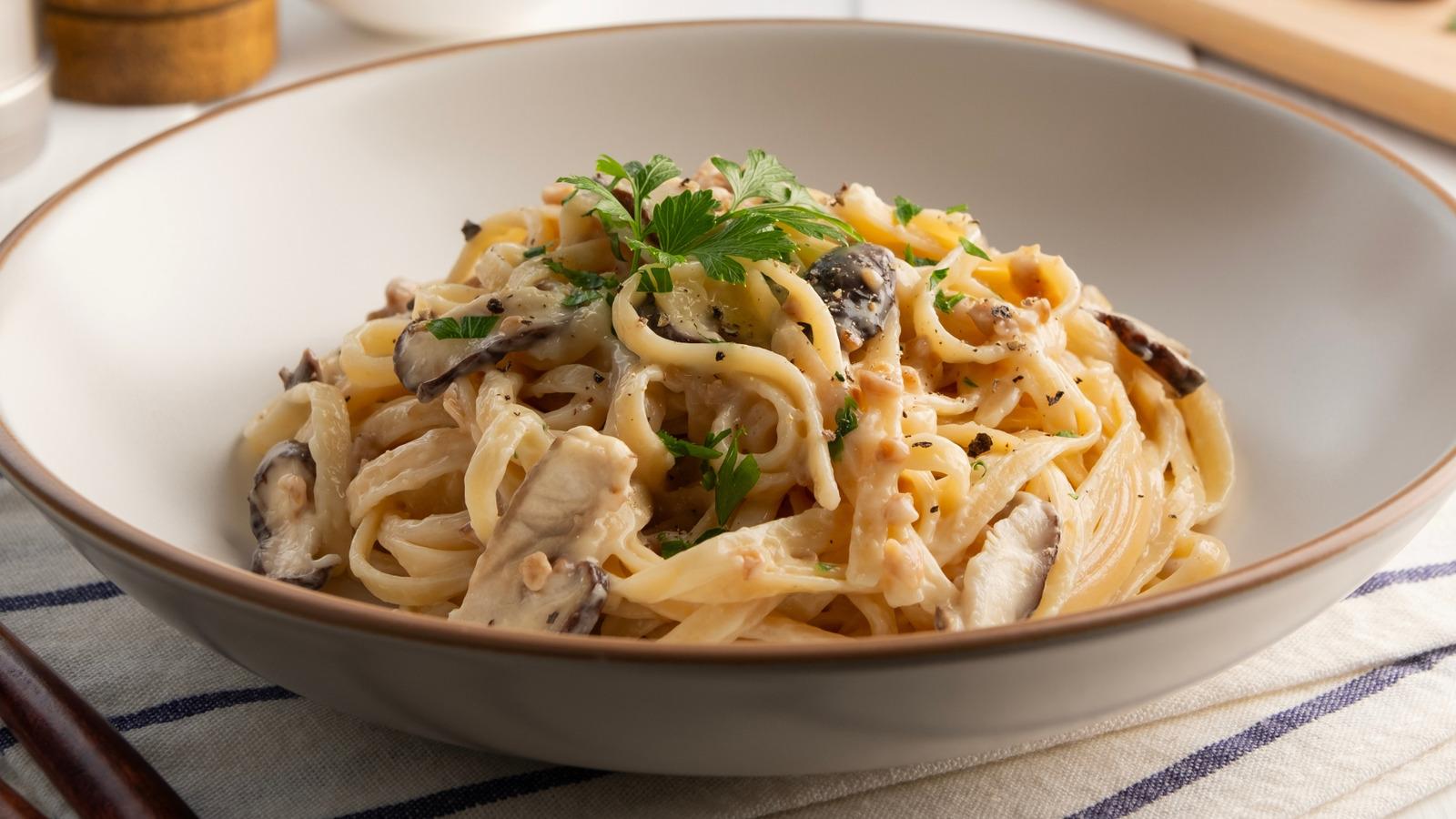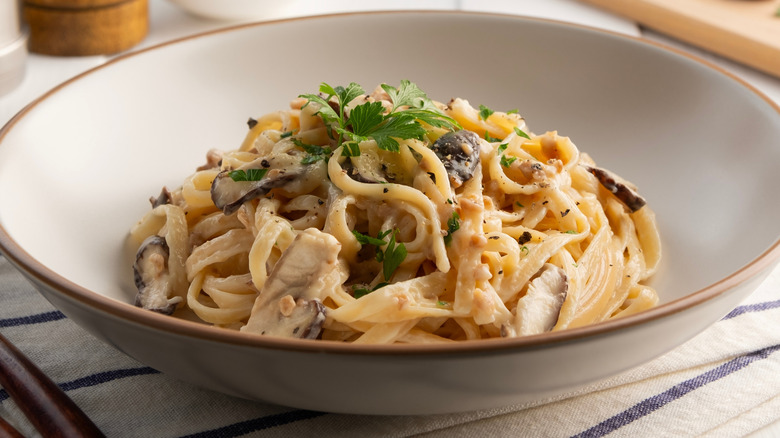
Kritchai7752/Shutterstock
When you think of pasta sauce, you might picture a rich Bolognese or a creamy Alfredo. You probably aren't thinking about the canned ingredients you can turn into pasta sauce. Now, before you pass this off as a gimmick, you need to understand that Italian food is hugely varied across regions and not all of it has made it to the U.S. So, there are many types of sauces you can make from canned items, beyond tomatoes.
Half my family still live in Italy and, as a food writer and recipe developer, Italian cuisine is one of my areas of interest. So, I've eaten and made a huge number of pasta dishes in my time. And many of these are ones the average person outside of Italy won't be familiar with. Italian cooking is all about simple, fresh ingredients, so many of these dishes are traditionally made with fresh produce. However, you can use canned ingredients to make them pantry-friendly. They might not end up quite as vibrant, but it will do in a pinch. You'll still end up with something delicious and you won't even have to venture out to the store.
You can use the same techniques as you would with fresh ingredients, adapting them to use up those canned peas or asparagus spears that have been languishing in your kitchen cabinets. Here are 13 canned items you can transform into pasta sauce. Some of them are traditional Italian recipes, while others have an international spin.
1. Chickpeas
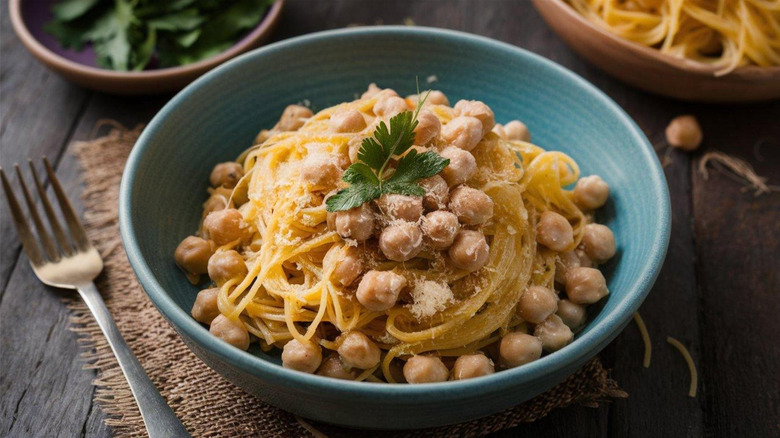
Food magic/Shutterstock
It might seem like using chickpeas to make a pasta sauce is an odd idea. You may worry that you'd basically end up making hummus. But it's not like that at all. Pasta e ceci — pasta and chickpeas — is a popular dish all over Italy, with most families having their own variation.
Some are quite soupy, filled with whole chickpeas and diced veggies in a broth. Others are blended, turning the chickpeas themselves into a pasta sauce. Thinned down with enough broth or pasta water, you get a smooth, creamy, fairly thin sauce, rather than something thick and pasty, like hummus.
While you can find many recipes online, it's not the kind of dish you absolutely need a fixed recipe for at all. You can use what you have and make it your own. Although some people might cook their legumes from dry, most of us don't have time for that — and it's very nearly as good using canned chickpeas.
You start with some aromatics — it might just be onion, or you could add garlic, carrots, and celery. After frying these, the most basic recipes will add the chickpeas and broth, simmer them with fresh rosemary or bay leaves, before removing the herbs and blending all of or some of the mixture to make a sauce. Other recipes contain potatoes, chili flakes, tomato paste, and other extras. Mix in your cooked pasta of choice and you've got yourself a tasty dinner.
2. Asparagus
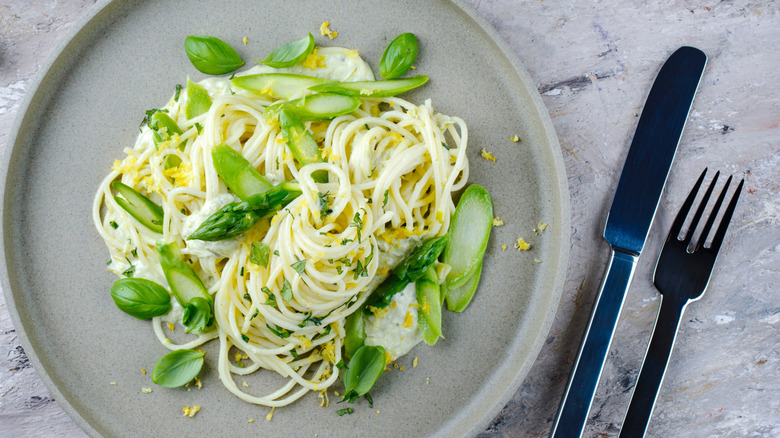
hlphoto/Shutterstock
Pasta with a sauce made from asparagus is traditional in some regions of Italy. It's a popular dish at the height of asparagus season — in spring and early summer. Cooking in Italy is often very seasonal, making the most of the country's excellent fresh produce. But using canned asparagus means you can make it year-round. And because you're blending the sauce, it doesn't matter if the spears are on the mushy side.
Like many dishes, there are a range of ways to make it. Generally, they start with sautéing chopped asparagus spears. Canned and jarred asparagus, either green or white, work here. Most recipes contain garlic and some use onion or shallots, but they aren't essential. Most of the flavor comes from the asparagus itself, but Parmesan, lemon juice, lemon zest, salt, and pepper can also add to it. You may also use heavy cream in the sauce, but my preferred version blends the asparagus without extra liquid, just adding some pasta water to thin it when mixing the noodles and the sauce. If you want some texture, leave some of the asparagus unblended.
3. Pumpkin
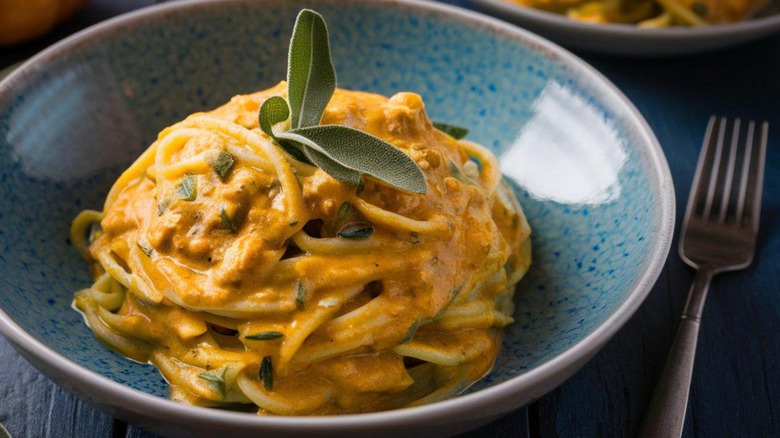
Food magic/Shutterstock
Pumpkin might not be the first thing you think of when it comes to pasta, but it's a sauce ingredient with real tradition behind it. In Naples, pasta con crema alla zucca — pasta with creamy pumpkin sauce — is a classic fall and winter dish. Fresh pumpkin is usually used, often from the sweet, dense-fleshed varieties that appear in Italian markets when the weather turns cold. But if you want to bring this dish into your kitchen without tackling a whole squash, canned pumpkin works surprisingly well.
The process is much the same whether you're using fresh or canned pumpkin. You'll start by gently sautéing aromatics in olive oil — often just onion, but garlic, sage, or rosemary are common additions. Then, you add the pumpkin, thinning it with vegetable broth or pasta water until you get the right sauce consistency. Salt and pepper are essential, of course, and a handful of grated Parmesan stirred in at the end adds richness.
While traditional crema di zucca keeps it simple, cooks outside of Italy have experimented with pumpkin sauces in many ways, including pumpkin Alfredo. We have an easy butternut squash pasta recipe that uses fresh pumpkin but could be adapted to use canned without too much trouble. You're not losing out by using canned pumpkin here. It's smooth, consistent, and easy to work with, making it a pantry-friendly shortcut. You get to enjoy a delicious dinner without the fuss of prepping fresh squash.
4. Coconut milk
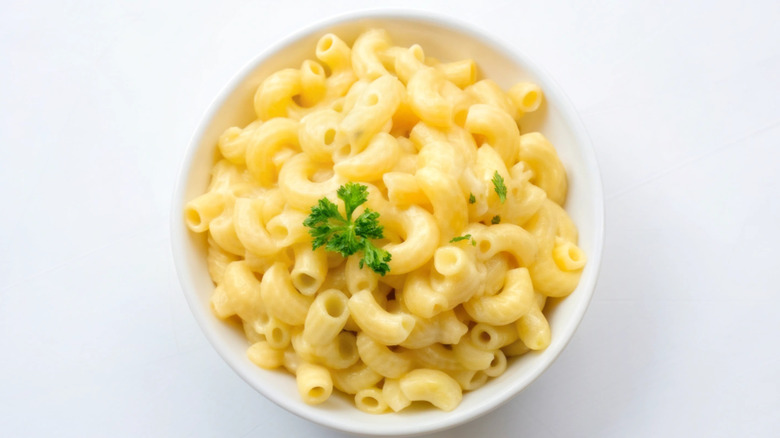
Maria Alam Sraboni/Shutterstock
While you won't find coconut milk in any traditional Italian recipes, it can be a nice addition when you want a creamy pasta but want to use up what you already have in your pantry. You can use it in place of heavy cream in all kinds of recipes, whether that's a classic Alfredo sauce, a rosé sauce, or any other creamy concoction. It also has the added bonus of being dairy-free, so it's a good alternative when you're inviting someone who's vegan or lactose intolerant over for dinner.
The thing to remember about using coconut milk is that the finished dish will retain a lot of that coconut flavor. So, if you're looking to make authentic Italian food, it's not the best option. If you're looking to make a vegan-friendly or dairy-free creamy pasta dish that tastes like the real thing, you're better off using commercial non-dairy heavy cream or homemade cashew cream.
What you'll get by using coconut milk is more of a fusion dish. Mixed with other ingredients to make a sauce, it will take on more of an Indian or South Asian flavor. If you stick with Italian herbs, it won't taste like a curry, but it will have those sweet coconut notes. It's a dish I enjoy, but you do need to come at it with the right expectations.
5. Peas

orsateodora/Shutterstock
The truth about pesto is that it doesn't have to be made with basil. It's a generic term for any ingredients pounded into a sauce — and peas actually make a delicious pesto. Turning peas into a sauce might sound left of field, but pasta e piselli — pasta and peas — is a common combo in Italy. Sure, using fresh or frozen peas for this is great, but if you have a can of peas that needs using up, this is your chance to turn it into something tasty.
To make this pea pesto, all you need to do is toast some pine nuts, and blend them up with your peas, garlic, fresh mint, and olive oil. You can use Parmesan or other hand cheese if you have it, but the recipe is still delicious without. Season it with salt and pepper and it's ready to use. Just stir it through cooked pasta, adding some of the cooking water to thin it if needed.
6. Roasted red peppers
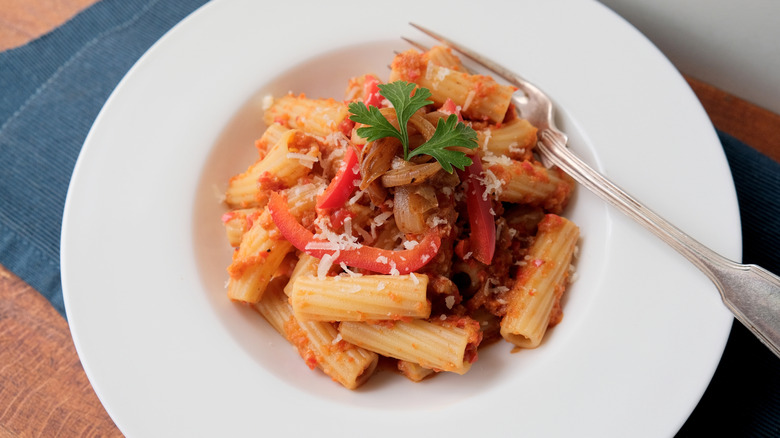
kokofoundit/Shutterstock
Roasted red peppers can transform a dish, adding sweetness and depth with barely any effort — especially if you buy them in a can or a jar. While they aren't the base of a traditional Italian pasta sauce, there are plenty of pepper-forward sauces across Italian and Spanish cooking that you can adapt for pasta, making good use of any roasted red peppers you've got tucked away.
One option is making a romesco-inspired sauce. Traditionally, it's a Spanish sauce made with roasted red peppers (or dried chiles), nuts (often almonds or hazelnuts), garlic, olive oil, and vinegar. It's brilliant tossed with noodles, even if that's not the usual way to eat it. You can blend canned roasted red peppers with toasted almonds, garlic, olive oil, smoked paprika, and a touch of sherry vinegar, thinning it with pasta water to get the perfect consistency.
Roasted red peppers can also be a base for many other pasta sauces. You can blend them into a creamy sauce by adding a heavy cream or ricotta. Another option is to add them to a tomato-based sauce, where their sweetness balances the acidity of the tomatoes and brings a subtle smoky flavor. You can sauté onion and garlic, add a can of tomatoes along with your roasted peppers, and blend until smooth, finishing with salt, pepper, and fresh basil.
7. White beans
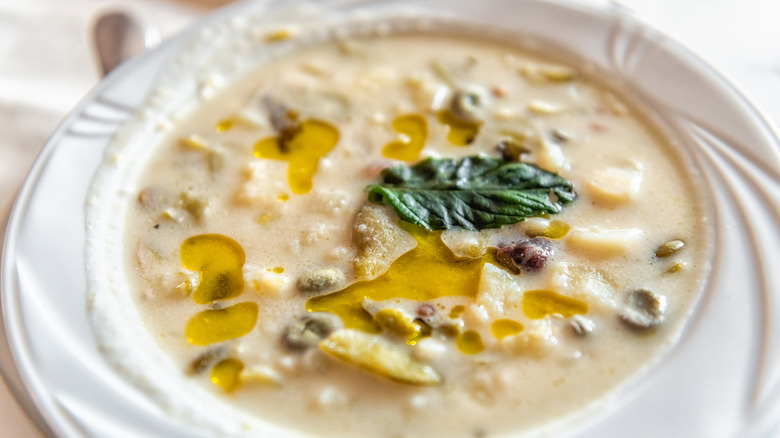
Kristi Blokhin/Shutterstock
Just like you can make homemade hummus with white beans, you can blend them up to make a creamy pasta sauce similar to pasta e ceci but with a twist. Beans such as cannellini, navy, and butter have soft insides that can whiz up into a perfectly smooth sauce that has a creamy consistency without having to reach for the dairy. It also provides a lot of protein in each serving, making it a nutritious choice.
It's extremely simple to make a pasta sauce using white beans — and there are so many options for customization. At the most simple end of the spectrum, blend beans with seasonings and enough liquid to get the right consistency, and you're ready to mix it with cooked pasta. But, you can make it much more flavorful with just a few extra ingredients.
Sautéed onion and garlic make a big difference, bringing layers of savory flavor that will take your pasta dish to the next level. Fresh herbs like basil, parsley, or rosemary also work well here. You could also simmer the aromatics with canned tomatoes before adding beans and blending to make a creamy tomato sauce.
8. Artichoke hearts
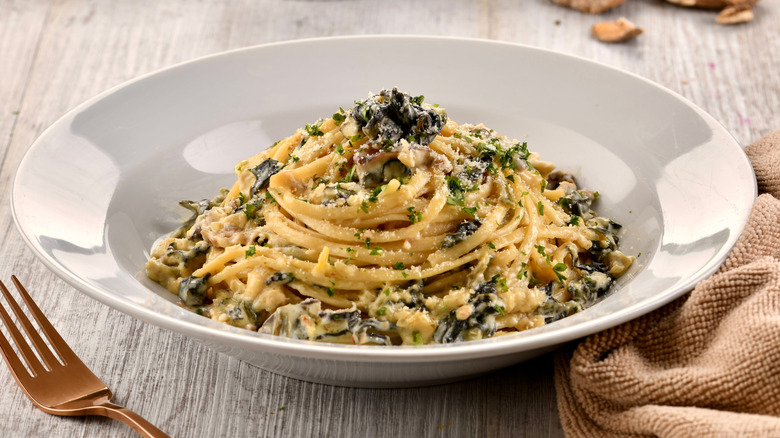
Food Shop/Shutterstock
Artichokes might seem like a fussy ingredient to prep, but canned or jarred artichoke hearts let you skip the trimming, boiling, and peeling while still adding loads of flavor to your pasta dishes. They're widely used in pasta dishes across Italy, and they pair beautifully with olive oil, garlic, and herbs to create a simple, flavorful sauce.
To turn canned artichoke hearts into a pasta sauce, you just need to drain them and blend with garlic, olive oil, lemon juice and zest, seasonings, and some hard cheese, if you like. This creates a simple creamy sauce that you can stir through cooked pasta. However, you can make a more elaborate version, if you like, sautéing onions as a base and adding wine and heavy cream.
There's a lot of scope for trying out different things with this dish, so let your preferences guide you to make a pasta sauce that you love. Using artichoke hearts straight from a can makes this dish so easy to prepare.
9. Olives
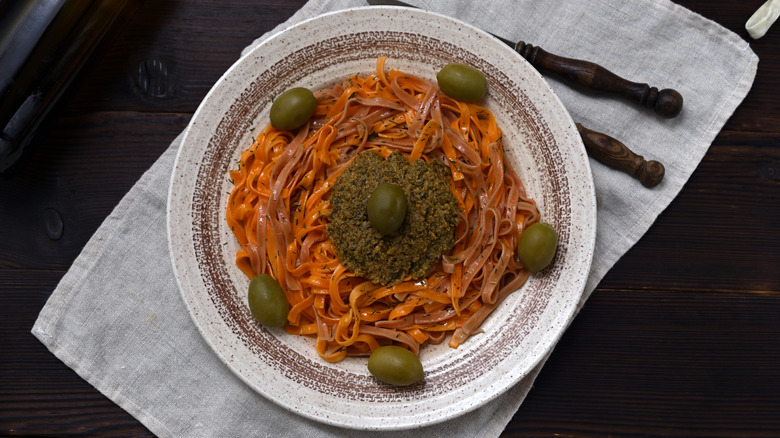
Viktoriia Kolosova/Shutterstock
Olives bring a big burst of flavor with minimal effort, and while you might think of them as something to scatter over pizza or eat alongside cheese, you can also use them in pasta sauce. One of the easiest ways to use canned olives in pasta is by turning them into a tapenade and using that as your sauce.
Traditionally, tapenade is served with bread or as a condiment. Using it as a pasta sauce isn't exactly traditional, but it works surprisingly well. There are lots of ways to make tapenade. Of course, you need olives, which can be green, black, or a mix of both. Some recipes contain capers, garlic, anchovies, and olive oil. But you might have a preference for using just some of these ingredients or trying different ones altogether. For instance, we have a tapenade recipe that uses horseradish to give it a kick.
Whatever ingredients you ultimately choose to add, just whizz them up in a food processor or blender and you have yourself a sauce. Then, you just toss it with cooked pasta along with some of the cooking water to loosen it up and help it coat the noodles. It's a quick, pantry-friendly option that we can get behind.
10. Lentils

Angelika Heine/Shutterstock
Lentil pasta is an Italian classic. It's not the sort of dish you'd get served up in a fancy restaurant but it's something your nonna might cook you on a cold winter night. It's warming, hearty, and has that magical Italian simplicity that turns basic ingredients into something special.
While this kind of dish is often made using dried lentils, canned brown or green lentils will do the trick here, too. You start by cooking some aromatics. At least onion, but preferably some carrots and celery, too. Some recipes call for garlic, but it isn't a given in Italian food, despite what many people believe. Then you add canned lentils and let the stock simmer for a while so the flavors mingle. Some recipes also call for fresh rosemary and canned tomatoes or passata.
You can choose to mash the lentils to make them a little saucier, but you can leave them if you like a chunky sauce. The pasta is usually cooked in with the lentils in this dish, so you add dried pasta and some extra salted water and cook everything until the noodles are al dente.
11. Cream of mushroom soup
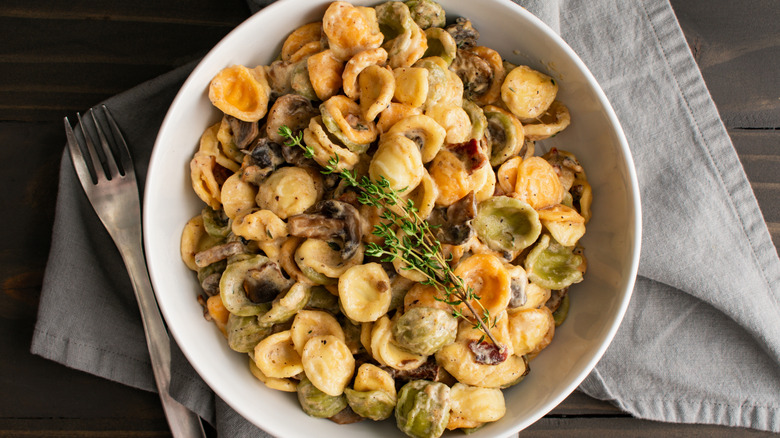
Candice Bell/Shutterstock
Using cream of mushroom soup as a pasta sauce is about as far from traditional Italian cooking as you can get, but sometimes you need a quick, comforting dinner without much fuss, and this pantry staple can come to the rescue. It's creamy and full of umami from the mushrooms, making it a surprisingly tasty option when you're in a pinch.
To turn it into a pasta sauce, simply heat it and adjust the consistency to make it saucy. Depending on whether or not it's condensed, you may need to loosen it or thicken it. Cornstarch is a good thickener, while milk or cream can thin it out. You can also use various techniques to upgrade mushroom soup, making your sauce tastier. A generous crack of black pepper and a pinch of chili flakes can go a long way, and if you have some fresh herbs like thyme or parsley, they'll add a lot of flavor. If you want to get fancy, you could add dried porcini mushrooms or drizzle over an infused oil.
Would my nonna endorse this? Probably not. But sometimes you just need a super simple dinner that's ready in as long as it takes to cook a pot of pasta. Finished off with a hard Italian cheese and a glug of quality extra-virgin olive oil, it isn't half bad.
12. Sweet corn
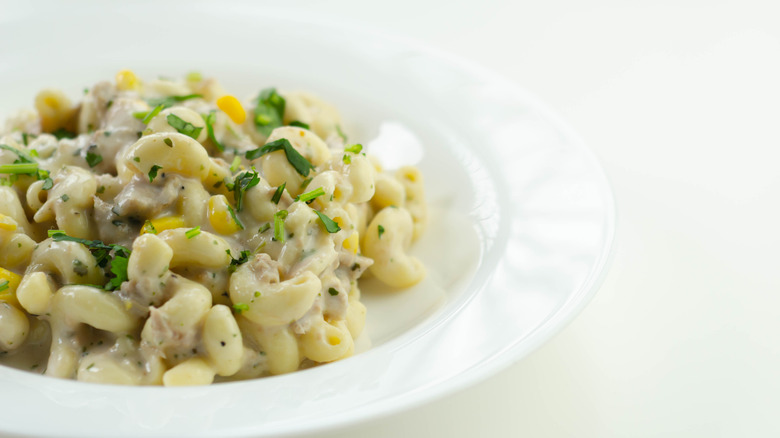
Q77photo/Shutterstock
Canned corn might seem more suited to tacos or succotash than pasta but, when blended, it turns into a deliciously creamy sauce. You don't need much more than corn to pull this off. And while some recipes may use fresh, a can of corn will do the trick when you want a quick, simple dinner.
Just sauté some onions or shallots and garlic, add corn, and blend half the mixture, so you have some sauce and some chunky bits. The natural sweetness of corn makes a light, summery sauce even in the middle of winter — and that's one of the benefits of the canned stuff: it's never out of season.
When you mix it with cooked pasta, you can thin it with some of the cooking water if needed. Adding hard cheese and a squeeze of lemon juice adds some extra flavor. You could also stir through your choice of fresh herbs. It's a great way to use up canned corn that goes beyond the usual options.
13. Sun-dried tomatoes
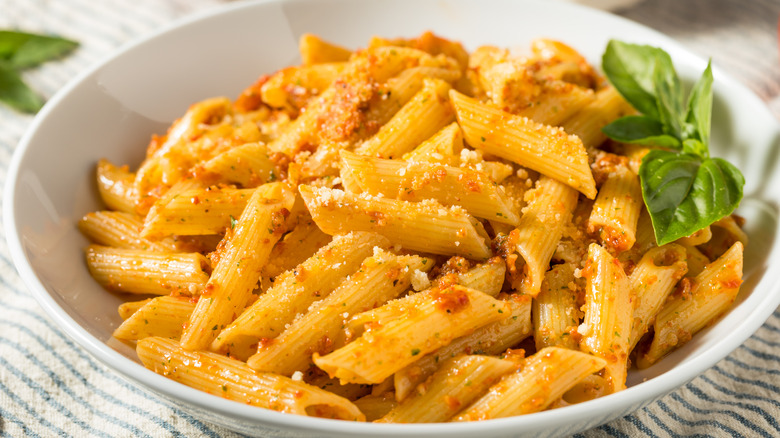
Bhofack2/Getty Images
If you like red pesto, you can easily make your own from canned sun-dried tomatoes. Their concentrated tomato flavor gives the sauce an intense, savory flavor. And it's a great way to keep enjoying tomato pasta when fresh tomatoes are out of season.
To make a quick sun-dried tomato pesto, simply add your canned or jarred sun-dried tomatoes to a blender or food processor with garlic, toasted nuts (pine nuts, almonds, or walnuts all work well), grated Parmesan, and a good glug of olive oil. Blend until you get a thick but spoonable paste, adjusting with extra oil or a splash of water as needed. You'll probably need to add some salt, but do this to taste after blending everything together. It's likely you'll need less than you think because of the salty hard cheese.
Once it's all come together, you just stir it with your cooked noodles and it's ready to go. As ever, a little of the pasta cooking water can help you get the right consistency if it's too thick.



